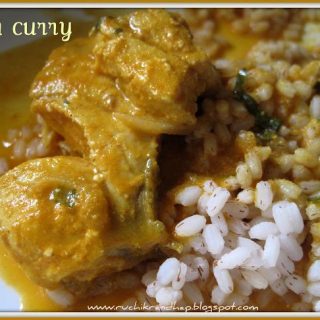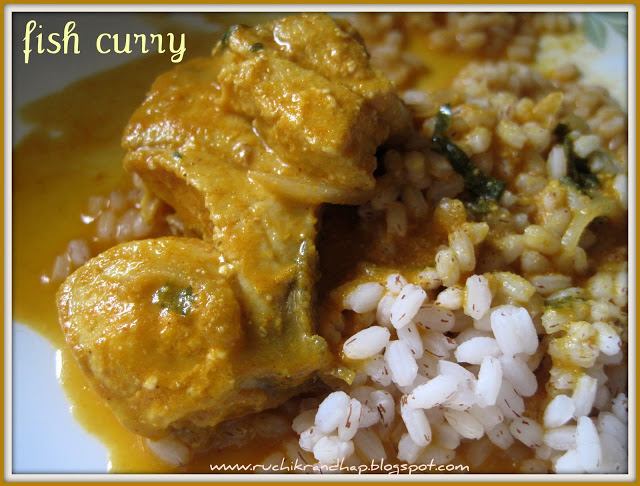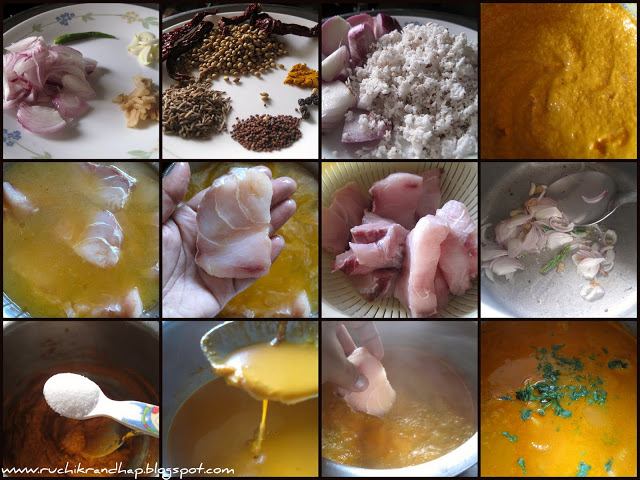Here’s one more fish curry that I make often. We get ‘Gol’ fish which is actually huge and its pieces (cubes) which are usually boneless is what is sold. This fish is pretty bland by itself and tastes better in a gravy than in it’s fried form. However, for the convinience of cooking (its sold skinless & in cubes – so minimum effort to clean as there are no scales either) I buy this fish occasionally & sometimes replace Surmai (King Fish) with Gol while preparing Fish Biryani. Unfortunately I do not know the English name of this fish, but you can make this curry for any fish like Pomfret, King Fish or Rawas too. As per the recipe you can make this curry for Mudav fish (as it’s called in Tulu) or Sanaki (Konkani/Tulu)

Fish Curry With Coconut for Sanaki/Mudav/Ghol
Coconut and spice based fish curry that is specially used for the preparation of sanaki/mudav or ghol fish. This pairs very well with red or white rice
Print
Pin
Rate
Ingredients
- 700 grams Ghol fish cut into cubes
For the masala
- 5 peppercorns
- 4 long dry red chillies
- 3 teaspoons coriander seeds
- 1 teaspoon cumin seeds
- 1/2 teaspoon mustard
- 1/4 teaspoon turmeric
- 1 medium size onion roughly chopped
- 3/4 cup grated coconut
- 1 tablespoon coriander leaves chopped
- salt to taste
- 1 teaspoon vinegar
For the Shindhaap (Ingredients to be fried before adding the masala)
- 1 small onion sliced
- 1 green chilli
- 1/2 inch ginger chopped fine
- 4-5 cloves garlic chopped
- oil
Instructions
- Clean the fish in some turmeric & salt water and set aside in a colander so that the water drains off – this helps in removing the fishy smell in the gravy
- Grind all the ingredients for the masala (except the salt & vinegar) to a fine paste
- Heat oil & fry the onion till golden. Add the green chillie & fry till transparent. Add the ginger & garlic & fry lightly – do not allow it to brown
- Add the ground masala & fry on slow flame till oil leaves the sides
- Add upto 1 1/2 cups of water. Leave the gravy a little thick – once the fish is added it will leave its own water (and some more if the fish has not been thawed completely if it was frozen)
- Bring the gravy to a boil and add the salt & vinegar. Check the taste. Let it boil for 1 minute before you add the fish pieces gently.
- When all the fish has been added to the pan, gently cover each piece with the gravy and give the pan a shake (twirl it a bit) so that the gravy has covered the fish well.
- Cover & leave the fish to cook on medium flame – you will notice the gravy bubbling up. Cook for about 2 minutes – not too long as fish cooks fast & you dont want it crumbling. The fish will continue to cook in the heat of the pan even after it has been taken off the stove
- Turn off the flame. Garnish with chopped coriander leaves & allow the curry to sit for a while
- Serve hot with boiled or white rice.
Disclaimer
The nutritional values are only indicative.
Tried this recipe?Please leave a comment & rate the recipe below or share a photo on Instagram and tag me @ruchikrandhap


I remember, during our childhood days in Mangalore, my Mom used to get 2-3 kilo's of chanaki fish fillets (Shiro's in Konkani)at a time and we used to relish this fish a lot. Thank you for bringing back my childhood fish eating memories back, which I very much miss out here in Bangalore. I Love your Blog and am a regular visitor here. Have tried some of your recipes too, and must say they all have turned out good. Keep up the good work.
Asha, that's a huge compliment, I am so honoured and touched to know that my blog brings back childhood memories. Thank you so much for all your kind words and i am happy to hear that the recipes have come out good, do keep checking often! I am on facebook too, you can get updates there!
http://www.facebook.com/pages/Ruchik-Randhap-Delicious-Cooking/173974419329543
I'd love to hear from you 🙂
http://www.facebook.com/pages/Ruchik-Randhap-Delicious-Cooking/173974419329543?sk=wall
I came across this site by accident. Now, thanks to you I've forgotten all about my work! 🙂 It's a great resource and my wife and I will definitely be referring to it a lot. My wife isn't Manglorean but she loves our food and is constantly hunting for recipes. Now, thanks to your hard work I just have to sit back and enjoy 🙂 (I mean that in a good way so hope no one takes offense.)
I like the interesting bits of information about life in Mangalore, such as in the Lepe recipe. I grew up there and immediately identified with what you've written. In that sense it's great that you've made this more than just a recipe centre. The site is informative, everything's written well and it's a good read all the way. Keep up the good work.
Al
Thanks a ton Al!! You said such nice things about my blog that I am pleased that all my efforts at creating this blog & updating it regular just paid off 🙂 So glad to know that it kept you occupied today 🙂 Do keep checking for more recipes, stories & information! Happy cooking!
Your recipes are a great help. Thank you. Should the coriander leaves be ground too in the masala for grinding.
Bernadine